Menu
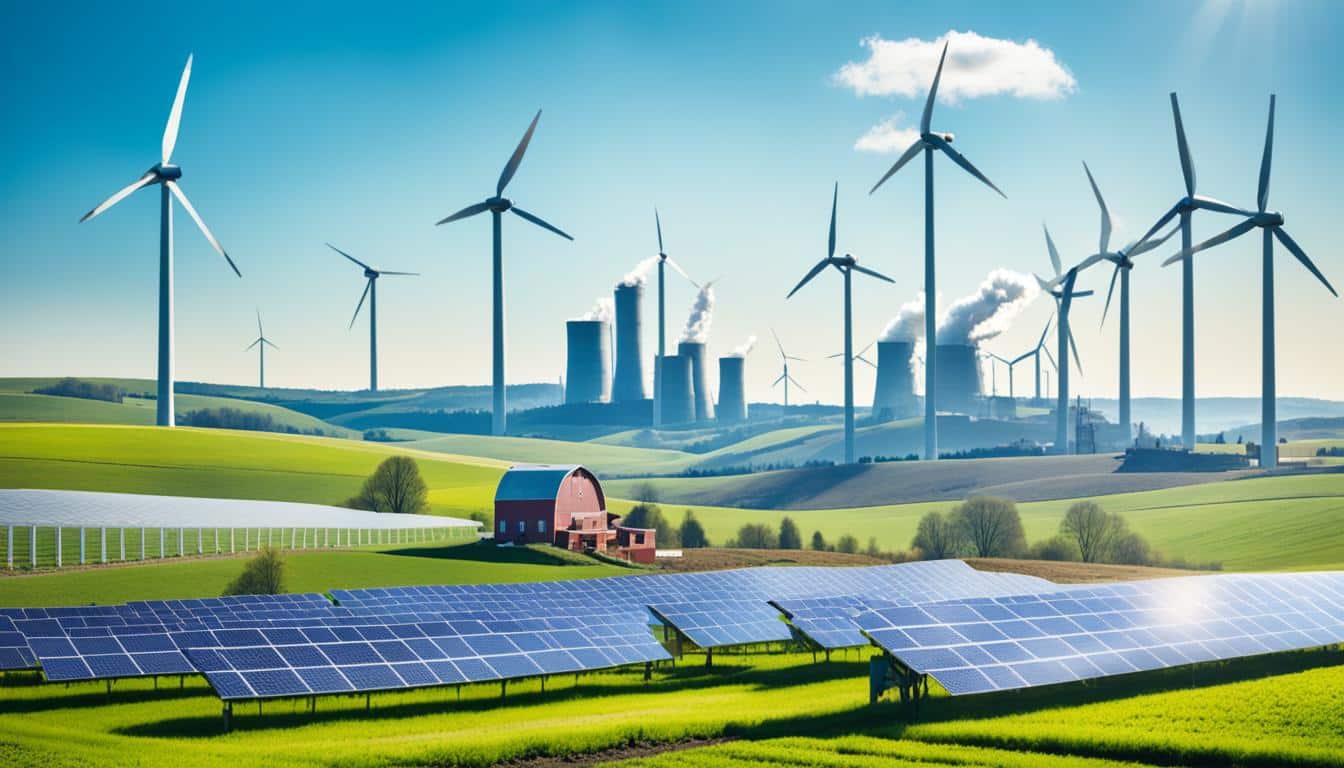
Did you know the United States is losing soil quickly? It’s happening ten times faster than it gets replenished. This issue not only makes food supply shaky but also makes global warming worse. But there’s good news. A study by the Argonne National Laboratory shows us a way out. It says new farming technologies and methods can reduce greenhouse gas emissions from growing grains by 70% in 15 years. That’s a big step towards a healthier planet.
This study has been made possible by funding from the DOE’s SMARTFARM program. It presents three big steps to make farming greener: make today’s systems better, change old tools for new ones, and rethink how we farm using digital means, better seeds, and electric tools. Scientists leading this work underline the need to act fast. They say by using both new tech and caring for the land, we can even one day have farms that don’t add to the greenhouse effect, instead they might even help reduce it. This plan is key. It guides both public and private money towards an agriculture that’s good for growing food, yet kind to the planet.
Worldwide, there’s a big push to reduce carbon footprint in agriculture. This shift is key to combatting climate change. With the goal to only raise global temperatures by 1.5 degrees Celsius, according to the 2015 Paris Agreement. Using eco-friendly farming methods is more important than ever. These methods use new technologies and modern farming practices to cut down greenhouse gas emissions. At the same time, they make farms more efficient and sustainable.
Changing how we use nitrogen fertiliser can help a lot. Applying smaller amounts more often during the year reduces nitrous oxide. This gas warms the planet 300 times more than carbon dioxide. Also, thanks to drones, we can be very precise in how we spread fertiliser. This stops unnecessary gases from forming.
Growing legumes as cover crops and then ploughing them back into the soil is great. It adds natural nitrogen to the soil, meaning we need less artificial fertiliser. Studies into adding special feeds for cows and other ruminants show they might lessen methane gas. But we have to be careful. Some of these feed additives might not be good for the animals.
About 30% of the world’s greenhouse gas emissions come from agricultural systems. Fertilisers and how we use our lands are a big part of this. Using anaerobic digesters to treat farm waste can help. This process reduces methane and captures usable biogas. Yet, the use of this biogas might not always make sense. That’s because it has less energy and can be less pure than regular natural gas.
Adding digital tools, improved genetics, and more electric farming is promising. These changes boost how we use resources smartly in farming. As we all push together to make agriculture cleaner, we also focus on storing more carbon in the soil. This keeps farms profitable and the planet healthy at the same time.
Digital agriculture and cutting emissions are closely linked. These digital tools help farmers manage their land better. This leads to a big drop in the gases farms release into the air. So, these new ways of farming help our planet.
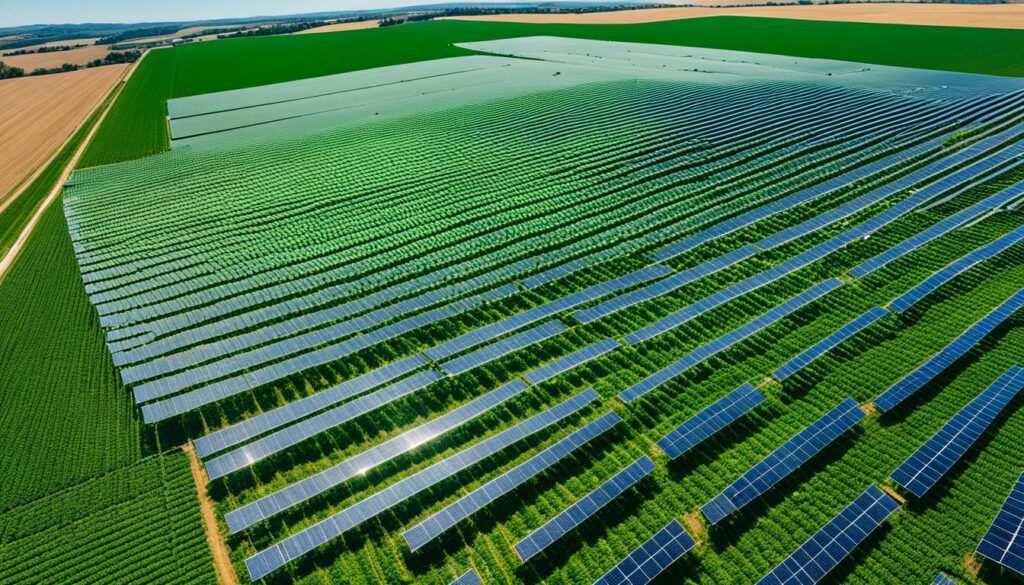
Using digital tools means farmers can be very precise in how they manage their land. Thanks to high-tech analyses, they know exactly when to use fertilisers and water. This careful approach lessens gas emissions while growing more crops. The proven success of these methods is seen in the reduction of harmful gases.
Precise farming techniques play a big role in cutting down emissions. They make sure resources like water and fertilisers are not wasted. By using GPS and smart sensors, farms can adjust how they care for their crops. This saves both money and the environment from overuse.
This high-tech farming, combined with genetic science and electrification, offers a real drop in pollution from farms. It aims to lower emissions across the whole farming process. Thanks to these technologies, farming can get greener, moving towards a more climate-friendly future.
Making big cuts in greenhouse gas emissions from farming depends a lot on using fertilisers better. Good fertiliser handling can greatly lessen nitrous oxide emissions. This gas is 298 times worse for our climate than carbon dioxide. Getting better at using nitrogen fertilisers is a top way to help the planet.
Applying fertiliser precisely helps both the environment and the crops. It’s about using the right fertiliser, in the right amount, at the right time, and in the right place. This method, known as the 4 Rs, boosts how plants use nutrients and cuts waste. Using high-tech tools in farming makes it easier to be accurate. This improves farm efficiency and is kinder to the environment. It also fits with farming in a way that keeps our world healthy for the future.
Managing fertilisers well is key to lowering nitrous oxide. More than half of nitrous oxide emissions come from agricultural soils. But, by using a smart plan for nutrients, we can cut these harmful gases. This includes being smart about which nitrogen sources we use and when, plus how much. Doing this, along with other steps like changing crops each year and planting in-between crops, is a good way to help the climate. It also makes farms more productive and sustainable.
| Practice | Environmental Impact | Economic Benefit |
|---|---|---|
| Precision Application | Reduced run-off and volatilisation | Enhanced nutrient efficiency |
| 4 Rs Management | Increased crop yield | Higher profitability |
| Comprehensive Nutrient Plans | Lower GHG emissions | Improved sustainability |

Blending crop and microbial genetics drives forward the capture of carbon in farming. These new methods have big potential to make farming greener. They help our world by using advanced techniques.
Improving crops through genetics helps store more carbon. Studies show special genes can cut down on harmful methane gas. As agriculture’s top greenhouse gas emitter, reducing methane is key. Enhancements like these are vital for lowering gas emissions.
Microbes in the soil are very important. They help soil deal with the effects of climate change. Recent research suggests they improve the soil’s structure and nutrient flow. This makes plants healthier and better at taking in carbon. Good soil health is crucial for plant life.
These technology-driven approaches are essential for carbon storage. By using genetic and soil health advances, we can tackle climate change. They are big steps towards sustainable, eco-friendly farming.
The electrification of farm machinery is making a big change. It’s cutting down on the use of fossil fuels. Electric tractors and green power in farming are key aspects of this change. They’re important for creating a sustainable future in agriculture.
Electric tractors bring big savings and help the environment. It’s much cheaper to charge an electric tractor than to fuel a diesel one. Over 15 years, a diesel tractor emits 90 tons of CO2. On the other hand, an electric tractor used the same emits only 10 tons. If it’s charged with solar power, this number drops to just one ton. This shows how electrifying farming can cut down on harmful emissions.
The current cost of charging an electric tractor from the utility grid is less than 15% of the annual diesel fuel cost, offering significant savings to farmers.
Using solar and wind power with electric tractors is good for the planet. It drops the carbon footprint and keeps energy costs stable. Places like the California Air Resources Board help by giving incentives. These help farmers change their old, polluting machinery for cleaner options. This helps with both saving money and the environment.
| Factor | Diesel Tractor | Electric Tractor (Grid Charged) | Electric Tractor (Solar Charged) |
|---|---|---|---|
| Annual Fuel Cost | 100% | 15% | 15% |
| CO2 Emissions (15 years) | 90 tons | 10 tons | 1 ton |
| Health Impact | High respiratory risks | Reduced risks | Minimal risks |
To wrap up, using electric tractors and renewable energy is essential. It’s more than a passing phase; it’s a must for sustainable and cost-friendly farming. This new technology is drastically cutting both costs and pollution. It’s making farming a better, cleaner industry for the future.
Climate-smart agriculture is vital for changing how we farm to ensure a green future. These programmes are open to many, like local governments, small businesses, and universities. This wide reach means many strategies can be shared for reducing greenhouse gases.
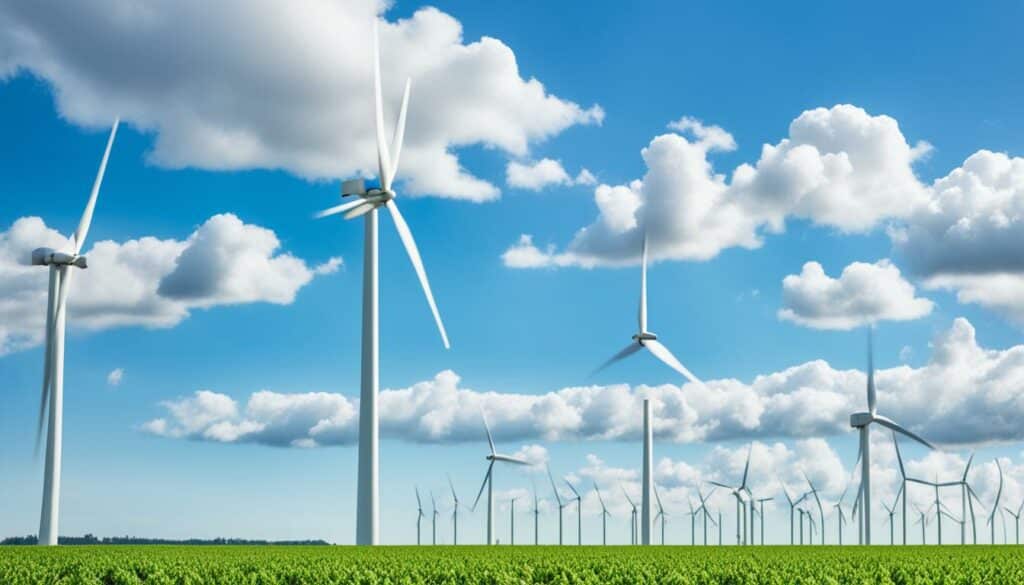
These programmes look at a range of factors when choosing who to fund. They check the benefits of producing climate-smart goods, the development of markets, fairness, and how well the project benefits the environment. Funding pools, ranging from under $5 million to over $100 million, focus on different key areas. For instance, large amounts aim to cut greenhouse gas levels, while smaller funds look more at being fair and helping everyone.
Taking part in these programmes not only helps the planet but also brings financial benefits. By using climate-smart methods in farming and forestry, these projects measure their impact on the environment. They also work on making markets for climate-friendly products. This two-pronged approach tackles reducing greenhouse gases in a big way.
Big projects in the first funding pool will have a broad effect, helping many farmers, including those who don’t get much help. Smaller projects in the second pool focus more on new ideas and making sure what is done is checked properly. There’s no set rule for outside funding, but any extra money from non-government sources is a plus, showing a focus on fairness.
To apply, get all needed documents ready and submit through www.grants.gov. You’ll need to provide things like the SF-424 form, your plan, budget, support letters, and the resume of the project lead. These steps make sure each application is carefully looked at. This helps choose the best, most fair ways to do climate-smart farm work.
Using eco-friendly ways in farming helps the soil and cuts emissions. Practices like conservation tillage and cover cropping do a lot of good. They are key in the fight for a healthier planet.
Conservation tillage method doesn’t disturb the soil much. It keeps carbon in the soil, making it a better carbon sink. This means less carbon dioxide in the air, helping combat global warming.
Farms can also earn money from “Carbon Credits” this way. It is a win-win for the environment and the economy.
Cover cropping is vital for green farming. It involves planting cover crops between main crops. This helps prevent soil erosion, fights weeds, and improves nutrients in the soil.
These cover crops make the soil healthier by improving its structure and adding organic matter. This leads to more life in the soil. Plus, it’s a good way to cut down on harmful emissions.
Sustainable agriculture practices cut greenhouse gas emissions and keep crops healthy. These include crop rotation, integrated pest management, and no-till farming. They all help meet the aim of lowering emissions in agriculture.
Crop rotation means changing the types of crops in one place each season. It keeps the soil healthy, lessens the need for chemicals, and controls pests. For example, planting different types like legumes and cereals together can improve natural nutrients. This reduces the use of chemical fertilisers and cuts down on emissions.
Integrated pest management (IPM) uses various methods to control pests without harming the environment. IPM lowers the use of energy-heavy chemical pesticides. By choosing IPM, farmers can lower their emissions.
Agroforestry mixes trees with farming and helps the planet in many ways. It adds more plant and animal life and helps capture carbon, which is good for the climate.
No-till farming does not plough the soil. This reduces the use of fossil fuels and helps store more carbon. It also stops soil erosion and keeps more moisture, making the land and crops healthier.
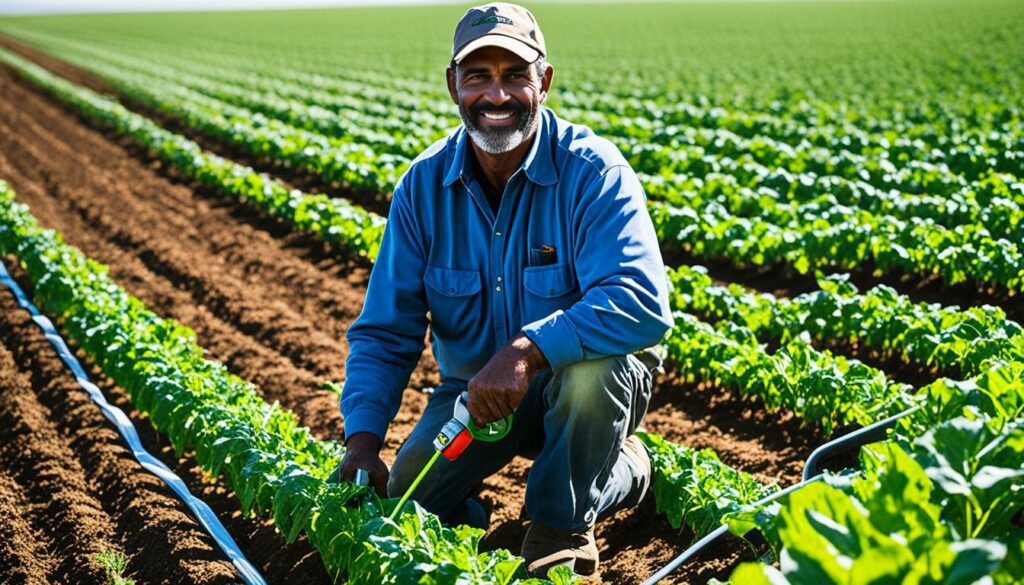
In cap-and-trade markets, agricultural businesses can earn money by cutting carbon. They sell credits for their green practices. This offers them a way to make extra money while protecting the environment.
The Renewable Fuel Standard and similar laws push for biofuel and clean energy projects. These boost green farming and give farmers reasons to lower their emissions. Such policies help in the fight against climate change.
Lowering agriculture’s greenhouse gas emissions is critical for fighting climate change. Using farming methods that produce fewer carbon emissions is key. This helps farms stay productive while helping the environment.
Farming activities make up about 30% of the world’s greenhouse gases. Methane and nitrous oxide are big parts of this. For example, nitrous oxide is about 300 times more potent at warming our planet than carbon dioxide.
To reduce these harmful gases, farmers can make a few changes. They can start using more renewable energy. For instance, they can grow crops for biofuel or set up wind and solar power.
Methane capture is another strategy. Technologies can capture methane from livestock and dairy farms. This includes managing manure in a more eco-friendly way.
Another smart move is to improve how they manage nutrients. This means using fertilisers better to cut down on harmful nitrogen emissions.
It’s important for farmers to find a balance between productivity and being green. They can lower their carbon footprint by being more efficient. For example, they can use fewer resources when they work the land. This not only cuts emissions but also stores carbon in the soil.
There’s also a scientific way to see how much carbon the soil is storing. It’s called the carbon-13 stable isotope technique. It checks soil health and carbon storage quality.
Using nuclear techniques can make feed for animals better. This can boost how much animals produce. And at the same time, it’s better for the planet.
Increasing the amount of organic material in the soil by using manure is helpful. So is growing crops that last year after year. These strategies keep farms productive. They also help lower emissions.
Overall, effective farming for reducing emissions mixes green ideas with business goals. With this blend, farms can lower their emissions significantly. And they won’t have to lose productivity to do it.
Government support for sustainable farming is crucial today. It helps tackle climate change’s effects on farmers. Agricultural activities are a significant source of greenhouse gases. So, programmes like the Agricultural Resilience Act (ARA) and the Inflation Reduction Act (IRA) play a big role. They aim to make farming more sustainable and resilient with financial help and expertise from the USDA.
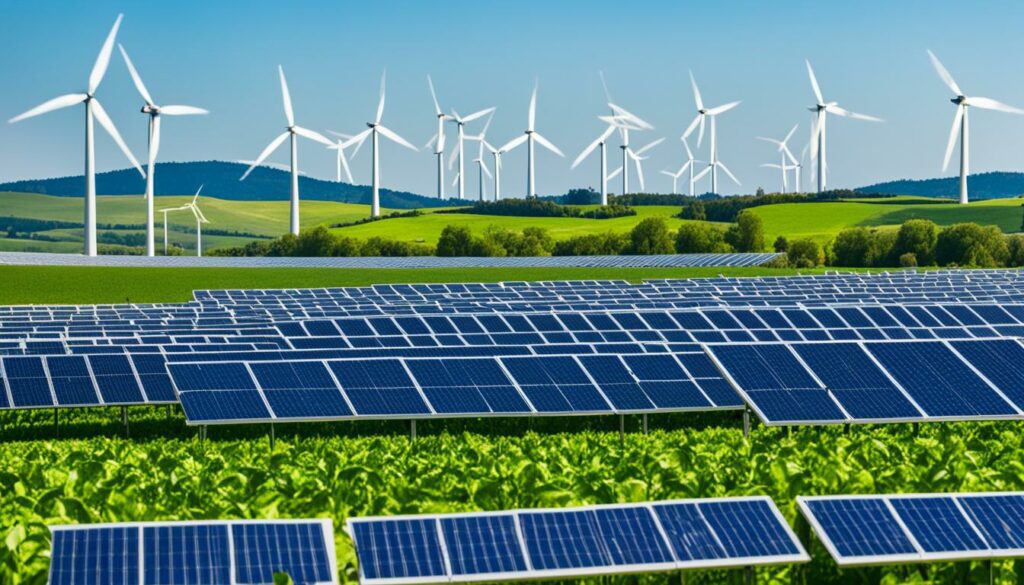
The USDA has various programmes to help farmers reduce their environmental impact. These include the Environmental Quality Incentives Program (EQIP), Conservation Stewardship Program, (CSP), Agricultural Conservation Easement Program (ACEP), and the Regional Conservation Partnership Program (RCPP). They focus on keeping the soil, water, and air clean while protecting wildlife. The IRA provides a lot of money for these efforts, making a bigger difference.
Through the USDA, farmers can get help to use more eco-friendly methods. EQIP, for instance, offers money and help to put climate-smart ideas into place. This support and advice mean farmers can better protect the environment. It increases the use of sustainable practices. Farmers also get expert advice, making sure they act wisely, based on the best science.
“NRCS offers technical assistance at no cost and provides personalised advice based on the latest science to help producers make informed decisions about their land.”
Continued USDA backing is very important for sustainable farming. This support helps overcome challenges and makes agriculture more resilient. It leads to an industry that is friendlier to the planet.
Many policies are trying to reduce greenhouse gas emissions in farming. But, there are big challenges in making them work. These challenges cover technology, money, and people’s habits. We need to solve these issues so that more farmers can use methods that are better for the environment.
One big challenge is the technology side of things. Farmers need high-tech tools for precision farming to cut down on emissions. But, not everyone can afford these tools. The lack of knowledge also makes it hard to use new sustainable farming technologies effectively.
Programmes like the USDA’s help with costs and knowledge. But, they are not used by everyone. This is partly because they are voluntary. It’s also tricky to prove exactly how much greenhouse gas emissions have decreased because of these farming methods.
Changing how farmers work can be hard because of social reasons. Many stick to old ways because it’s what everyone does. They are also afraid of the risks that come with trying something new. This makes adopting new, eco-friendly strategies tough.
Market-based ag-GHG credits could make a difference. They let farmers earn money by selling credits for offsetting emissions. There are also grants for producing goods with fewer greenhouse gases. These can attract eco-conscious buyers who don’t mind paying more. But, farmers need a lot of support and knowledge to switch to these greener methods.
### Barriers Analysis Table:
| Barriers | Description | Potential Solutions |
|---|---|---|
| Technological | Lack of access to advanced, cost-intensive technologies. | Increased investment in affordable, user-friendly technologies. |
| Economic | High costs and financial risks associated with new practices. | Enhanced financial assistance and subsidies from government programmes. |
| Social | Adherence to traditional methods and social norms. | Educational campaigns and community engagement to promote sustainable practices. |
| Behavioural | Reluctance to adopt new, unfamiliar methods. | Support mechanisms and incentive schemes like market-based ag-GHG credits. |
Market-based solutions in farming offer a strong way to push farmers towards going green. The Partnerships for Climate-Smart Commodities (PCSC) has given $3.1 billion to 141 projects. This money shows how market approaches can make big changes.
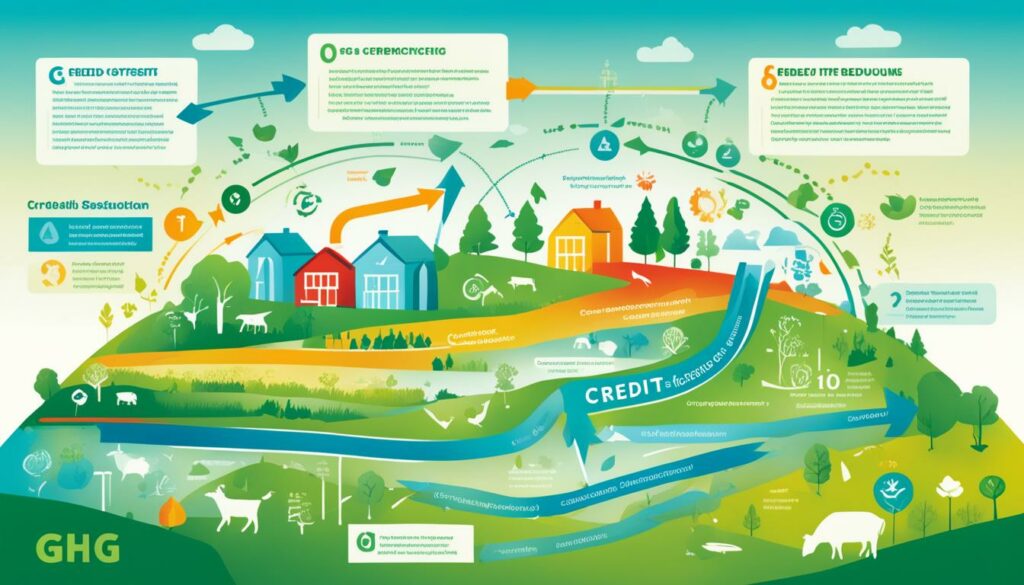
Emission credits are key in encouraging farmers to choose low-GHG methods. California’s cap-and-trade programme and the Growing Climate Solutions Act (GCSA) jump in here. They help by offering guidance and issuing credits for cutting emissions.
These actions not only motivate farmers. They also help in reaching climate goals.
Companies like Bayer and Nori push forward with private GHG credit systems. The precision in measuring emission cuts is crucial. Studies support the use of these systems.
When farmers sell these credits, they find a new source of income. This supports their eco-efforts and encourages the use of green farming practices.
California’s AB32 and the EU’s Emissions Trading System now cover agriculture. This shows how important farming’s emissions have become in rules.
These GHG credits can drive private money and new ideas. They’re leading us to a greener farm sector that’s both productive and eco-friendly.
Innovations in farming are key to cutting down greenhouse gases. Both public and private funds are needed to push these forward. The Greenhouse Gas Reduction Fund, with $20 billion, has started competitions. These aim to encourage the creation and use of new tech.
$14 billion goes to the National Clean Investment Fund, and $6 billion to the Clean Communities Investment Accelerator. They support projects that could cut climate pollution by 40 million metric tons yearly. By investing in farming tech, they lay the groundwork for reducing emissions more.
Partnerships between the public and private sectors are vital in the fight against farm emissions. For every federal dollar, almost $7 from private sources is matched. This strategy shows how working together in funding research and development can have a big effect.
| Program | Funding Allocated | Impact |
|---|---|---|
| National Clean Investment Fund | $14 billion | Reduction of climate pollution by 40M metric tons annually |
| Clean Communities Investment Accelerator | $6 billion | Mobilizes public-private investment ratio nearly 7:1 |
Over $14 billion is set aside for the less fortunate and those in need. The Greenhouse Gas Reduction Fund shows a strong focus on helping everyone grow while being sustainable. The USDA’s work with $2.8 billion stresses the ongoing need for research and teaming up. Such steps encourage new ideas, offer fair chances, and make farming more resilient.
Finding balance between farm resilience and greenhouse gas reduction farming is key today. Agriculture and food make up over a third of global greenhouse gas emissions. This amounts to a huge 18 billion tons each year. So, we must work on keeping farms productive but also lower their harm to the planet.
Since the 2015 Paris Agreement, we’ve seen new and team-driven ways to reach these aims. For example, the APEC PPFS is focusing on cutting methane, using fertilisers better, and getting ready for changing climates. These steps look to shape a farming future that is not only sustainable but also works well for everyone.
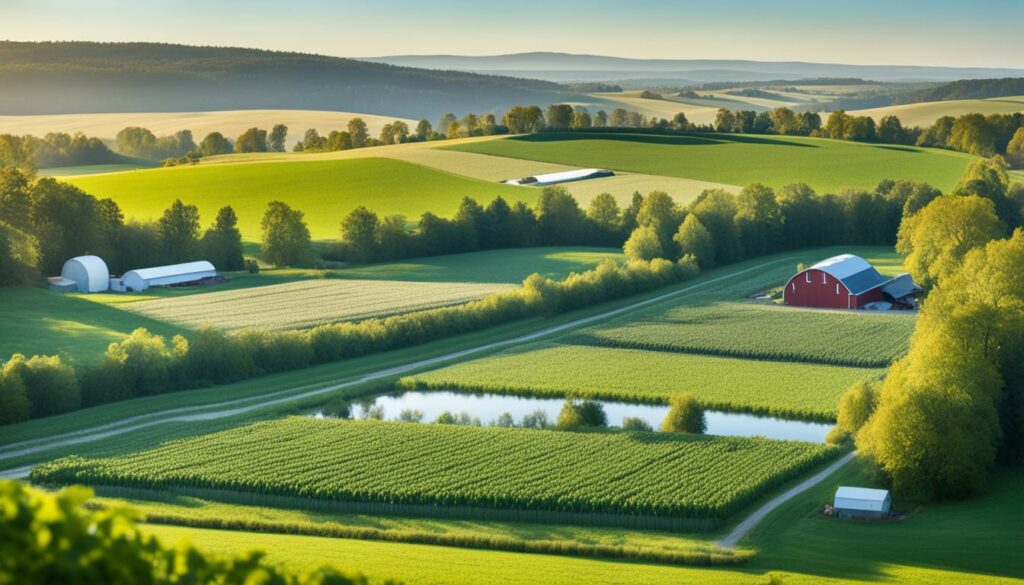
The PPFS, starting in 2011, has taken big steps to make sure there’s enough food, especially in poorer and remote areas. In 2021, they set out their plans for safer and healthier food, despite climate issues.
The USDA in 2021 moved along with the US government’s climate plans through a new 2022-2026 Strategic Plan. This shows wide attempts to bring climate-savvy methods into farming. They’re setting clear targets to make sure farms are not just tough but also eco-friendly.
The USDA also talks about looking after those who are most at risk from climate change, like Tribal nations and rural areas with low income. The goal is to cut greenhouse gases, boost soil health, and make farms more productive. This strategy is all about working together in new ways, welcoming everyone, to build a farming world that can handle tough weather.
| Year | Key Initiative | Outcome |
|---|---|---|
| 2011 | Launch of PPFS | Tackled food security in APEC regions |
| 2021 | Food Security Roadmap Towards 2030 | Strategic access to nutritious food |
| 2022-2026 | USDA Strategic Plan | Promoted climate-smart agriculture |
In a nutshell, succeeding in farm resilience and cutting greenhouse gas reduction farming needs a wider approach. By adapting and lessening harmful effects, we can form farming systems that are both lasting and less damaging to our planet. This effort will help our future generations to do well in a world changed by climate.
I’ve looked at several instances of low-carbon farming. I found examples that set new standards for farming. These examples show how new methods can really work. And they give important tips for those in the field.
The Kenya Agricultural Carbon Project is a great example. It helped about 30,000 farmers, many of whom were women. They showed that farming in a way that uses less carbon can work well.
This project used methods like improving the soil and using water better. It also got help from the government for better tools and using renewable energy.
From these studies, we’ve learned a lot. New farming technologies, like precision farming, make a big difference. They help use water, fertilizers, and pesticides in smarter ways.
A study in Bangladesh found that using solar pumps is better than diesel ones. They help the farmers earn more money and are less risky.
Even though low-carbon farming is good, it isn’t easy to start. It can be quite expensive at first. And some farmers find it hard to change their ways. They worry about money and if the new ways will really work.
But, these studies also show that with the right training and knowledge, it’s possible. For example, a project in Vietnam taught farmers better rice farming. This not only cut down on greenhouse gases but also boosted their crops.
| Project | Region | Main Achievements |
|---|---|---|
| Kenya Agricultural Carbon Project (KACP) | Kenya | Improved soil fertility, increased water retention, and nutrient absorption |
| Solar Irrigation Study | Bangladesh | Higher profitability and reduced investment risk |
| AgResults Vietnam GHG Emissions Reduction | Vietnam | Reduced GHG emissions and increased rice yields |
These studies prove that low-carbon farming is not just a dream. It’s something we can do. The lessons they teach are a great guide for those wanting to farm better. They show the way to more produce and less harm to our planet.
Farming makes a big impact on reducing greenhouse gases. It causes about 30% of emissions. To cut these emissions, we need to use new and smart techniques. Nuclear and isotopic methods are showing us how to measure these impacts and lower emissions. This shows we should use more science in farming to help the environment.
For farming to be green, it needs to be sustainable and productive. We can boost productivity and use fewer resources by doing certain things. Crop rotation, conservation tillage, and ground cover are great examples. We can also lower emissions by adding special substances to soil that control how nitrogen works. This matters because it cuts down on a gas that heats the planet a lot more than CO2.
Making farming greener needs money and working together. Governments and private companies must invest in new farming technologies. This helps farmers switch to more sustainable ways. Also, laws and plans that encourage green farming are very important. They help make sure everyone starts doing farming in a way that’s good for the planet.
To end, we need to keep working hard to make farming sustainable. With new tech, support from policies, and enough money, we can lower greenhouse gases. This way, we can have a farming that is strong, makes a lot of food, and helps the earth. It’s about making sure farming meets our needs without hurting the planet.
Digital agriculture optimises farm management through precise tools. These tools make applying fertilisers and water more accurate. This reduces excess use and lowers the carbon footprint, making agriculture more sustainable.
Precision agriculture ensures the exact application of inputs to minimise waste. It cuts nitrous oxide emissions, a potent greenhouse gas. This process lowers the overall carbon footprint, improves crop yield, and uses nutrients more efficiently.
Optimising fertiliser use decreases run-off and volatilisation, cutting nitrous oxide. It reduces the environmental impact. This approach boosts nutrient efficiency, crop yield, and supports eco-friendly farming.
Genetically enhanced crops are designed to absorb and store more carbon. This helps reduce atmospheric greenhouse gas levels. It supports sustainable farming’s goal of cutting emissions.
Microbial innovations improve soil health by cycling nutrients and aiding plant growth. They sequester carbon in the soil. This decreases the use of chemical fertilisers, cutting greenhouse gases.
Electric tractors and machinery cut reliance on fossil fuels, reducing the carbon footprint. They are part of low-carbon farming and often use renewable energy like solar or wind.
These programmes encourage farmers to use climate-friendly methods. They do this by giving certifications and premium prices for low-GHG products. This promotes sustainable farming practices widely.
Conservation tillage doesn’t disturb the soil, helping maintain its structure and carbon. It keeps soil healthy and lowers carbon dioxide emissions. This is vital for eco-friendly farming.
Cover cropping stops soil erosion, enhances nutrient cycling, and boosts soil health. It promotes emission reduction and makes farms more resilient. These practices are key for sustainable agriculture.
Using renewable energy, capturing methane, smart nutrient management, and electrified farming are key strategies. They significantly cut emissions while maintaining farm productivity.
The USDA offers financial and technical aid through programmes like CRP and EQIP. These help farmers adopt eco-friendly methods, supporting sustainable farming.
There are issues like technological barriers, economic risks, and measuring emission reductions. Overcoming these challenges is crucial for the widespread use of low-GHG farming practices.
Emissions reduction credits give financial rewards for low-GHG farming. They create marketable credits that offer extra income. This incentivises sustainable farming.
Investments are needed in new technologies, research, and public-private partnerships. They are essential for innovative emission reduction solutions in farming.
Climate-smart practices can adapt to weather changes and cut emissions. This approach ensures farms are sustainable and productive.
There are many successful stories of low-carbon farming. These cases offer insights into making farming more sustainable with positive results.